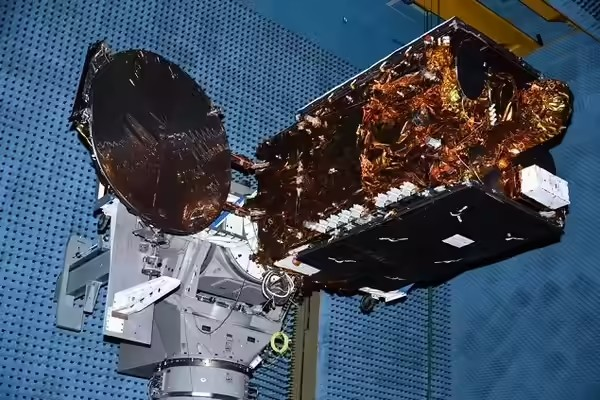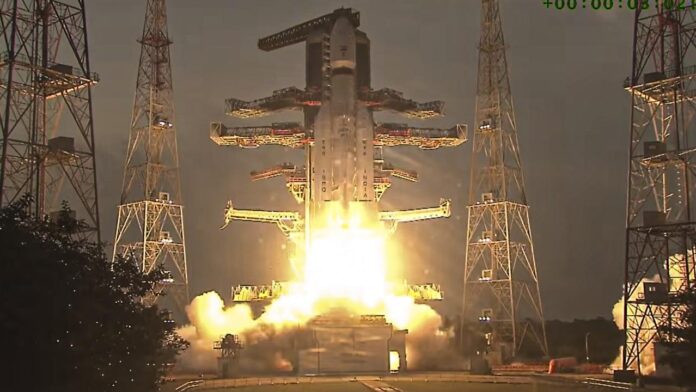Kamal Shah
With the flawless launch of the CMS-03 satellite, India’s space program has not just reached orbit; it has achieved a new plane of strategic independence.
The LVM3 rocket, now with a proven track record, has shattered that dependency. ‘Bahubali,’ true to its name, has demonstrated the muscle to carry India’s heftiest ambitions on its own shoulders. This capability is the basis upon which the future of India’s space economy and security will be built.
This was not merely another successful mission for the Indian Space Research Organisation (ISRO). It was a statement that India has decisively arrived as a fully self-reliant power in the heavy-lift space arena.
The significance of this launch transcends the impeccable technicalities of placing a 4,400-kilogram communication satellite into a geosynchronous transfer orbit. It marks the culmination of a long-held ambition and the closing of a critical strategic gap. For decades, India’s heavier communication satellites had to ride foreign rockets, primarily those of European launch providers. This dependency was not just a line-item expense; it was a vulnerability. It constrained launch schedules, ceded control over sensitive payloads, and limited our strategic options.
The payload, CMS-03, also known as GSAT-7R, underscores a critical dimension of this achievement: national security. This satellite is not just a commercial asset; it is a sentinel in the sky.. As the advanced successor to the GSAT-7, its primary mandate is to serve the Indian Navy. In the vast and strategically vital expanse of the Indian Ocean Region, where secure, real-time communication is mandated, CMS-03 will provide our naval assets with an unassailable, high-bandwidth network.
This ensures that our warships, submarines, and aircraft can communicate seamlessly, sharing data and intelligence without reliance on potentially vulnerable terrestrial or foreign-controlled systems. In an era of increasing maritime presence by rivals, the sovereign control of such a capability is paramount. ISRO has, once again, proven to be a silent but indispensable pillar of our national defence.
Beyond security, the LVM3’s success is the key that unlocks the next chapter of India’s space saga. It is the vehicle designated for the Gaganyaan mission, which will carry Indian astronauts to space. Its reliability is central to that milestone endeavour. Furthermore, its substantial payload capacity—8,000 kg to Low Earth Orbit—makes it a compelling workhorse for the future.
The success also positions India as a major player in the global commercial launch market. As the world enters a new space age, dominated by mega-constellations of small satellites, the ability to launch multiple payloads in a single, cost-effective mission is a tremendous competitive advantage. The LVM3 positions ISRO and its commercial arm, NewSpace India Limited (NSIL), to capture a significant share of this exciting market, fueling a domestic space industry and creating a vibrant ecosystem of innovation and jobs.
The journey to this moment has been tangible evidence of ISRO’s work ethic of achieving maximum output with minimal resources. It is, in fact, a sophisticated model of frugal engineering and strategic planning. ISRO did not attempt to build a heavy-lift rocket overnight. It systematically developed and upgraded its capabilities over decades, mastering each step of the technological ladder. The Polar Satellite Launch Vehicle (PSLV) became the reliable ‘workhorse,’ and the Geosynchronous Satellite Launch Vehicle (GSLV) mastered the complex cryogenic technology. The LVM3 is the mature, powerful culmination of that sustained effort.

This approach stands in stark contrast to the blank-cheque models of other spacefaring nations. It is a testament to Indian ingenuity, long-term vision, and a steadfast commitment to self-reliance.
| Mission Aspect Details Launch Vehicle LVM3-M5 (nicknamed ‘Bahubali’) Satellite CMS-03 (also identified as GSAT-7R) Launch Date & Time: November 2, 2025, at 17:26 ISTLaunch Site Satish Dhawan Space Centre (SDSC), Sriharikota Satellite Mass Approximately 4,400 kg Target Orbit Geosynchronous Transfer Orbit (GTO) Mission Life Designed for at least 15 years |
The successful launch of CMS-03 is not a destination, but a powerful launchpad for the future. The challenges ahead are formidable. The global space race is accelerating, with private players and nations investing billions in reusable rockets, interplanetary missions, and space mining. To remain competitive, India must continue to innovate aggressively, particularly in reusable launch vehicle technology.
The LVM3-M5 mission is a resounding affirmation that we are on the right path. As CMS-03 settles into its orbital slot, silently beaming its signals across the oceans, it stands as a symbol of a nation that is no longer content to be a spectator in the space age but is determined to be a leading architect of its future. The ‘Bahubali’ has spoken; India’s voice in space will only grow louder.


